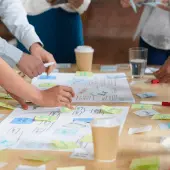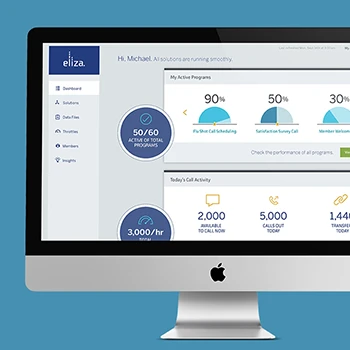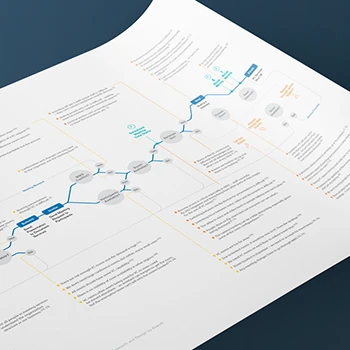What exactly is service blueprinting and why is it essential for service delivery?
Service blueprinting maps the complete service delivery system from customer-facing interactions down to backstage operations and support processes. Through our Experience Thinking framework, blueprints capture how brand expression, content delivery, product functionality, and service interactions connect to create cohesive customer experiences. Like architectural blueprints guide building construction, service blueprints guide consistent service delivery.
Tip: Think of service blueprinting as creating the foundational architecture that ensures every customer interaction reflects your intended experience design.
How does service blueprinting differ from customer journey mapping?
Customer journey mapping focuses on the external customer experience, while service blueprinting reveals the internal organizational structure that enables those experiences. Blueprints show the people, processes, technology, and support systems required to deliver each journey moment. Experience Thinking blueprinting connects customer-facing experiences to backstage operations across all service dimensions.
Tip: Use journey maps to understand what customers experience, then use service blueprints to design how your organization will deliver those experiences consistently.
What are the key components of an effective service blueprint?
Effective blueprints include experience lifecycle phases, customer goals and actions, front-stage digital and human interactions, backstage operations, support processes, and success metrics with improvement opportunities. Our template structure maps these components across lines of interaction and internal visibility to show how customer experiences connect to organizational capabilities.
Tip: Focus blueprint detail on the service elements that most impact customer satisfaction and operational efficiency rather than documenting everything equally.
When should organizations invest in service blueprinting consulting?
Blueprinting provides the most value when launching new services, improving inconsistent service delivery, scaling service operations, or integrating multiple service touchpoints. Organizations experiencing service quality issues, operational inefficiencies, or customer experience fragmentation benefit significantly from comprehensive blueprinting.
Tip: Consider blueprinting when service delivery inconsistency is affecting customer satisfaction or when scaling requires systematic operational understanding.
How does Experience Thinking enhance traditional service blueprinting?
Experience Thinking blueprinting integrates brand consistency, content strategy, product integration, and service delivery into unified service architecture. Rather than focusing only on operational processes, we design blueprints that ensure customer experiences align with brand promise while optimizing internal operations for sustainable delivery.
Tip: Choose blueprinting approaches that connect customer experience design to operational capability rather than treating them as separate planning activities.
What level of service complexity requires professional blueprinting consulting?
Services involving multiple touchpoints, cross-departmental delivery, technology integration, or customer journey complexity benefit from professional blueprinting. Single-interaction services may need only basic mapping, while multi-phase services with various stakeholders require sophisticated blueprint architecture and facilitation expertise.
Tip: Assess whether your service complexity exceeds internal mapping capabilities before deciding between self-service tools and professional consulting.
How do service blueprints support service innovation and improvement?
Blueprints reveal service delivery gaps, inefficiencies, and innovation opportunities by making invisible processes visible. Through Experience Thinking analysis, blueprints identify where brand expression can be strengthened, content can be optimized, product integration improved, and service delivery enhanced for competitive advantage.
Tip: Use blueprints as innovation tools to identify improvement opportunities rather than just documentation of current service delivery methods.
What's your step-by-step process for creating service blueprints?
Our process includes stakeholder consultation, comprehensive front and backstage audits, people and service research, and collaborative blueprint development. We follow Experience Thinking methodology through innovation, strategy, design, and delivery phases, ensuring blueprints capture both customer experience vision and operational reality.
Tip: Plan blueprinting as an iterative process that refines understanding through research and stakeholder collaboration rather than one-time documentation exercise.
How do you conduct front-stage and back-stage service audits?
Front-stage audits examine all customer-visible interactions including digital touchpoints, physical environments, and staff behaviors. Back-stage audits map internal processes, technology systems, support functions, and third-party dependencies. We analyze both operational efficiency and experience quality across all service delivery layers.
Tip: Include actual service observation and employee interviews in audits to capture service delivery reality beyond documented processes.
What research methods inform your service blueprinting approach?
Research methods include ethnographic observation, staff interviews, customer journey analysis, mystery shopping, focus groups, and surveys. Experience Thinking research examines how customers perceive service delivery while understanding internal operational constraints and opportunities for improvement.
Tip: Combine customer research with employee insights to understand both external service perception and internal delivery challenges.
How do you facilitate collaborative blueprint development sessions?
Collaborative sessions bring together cross-functional stakeholders to map service delivery collectively, identify gaps, and design improvements. We facilitate workshops that balance diverse perspectives while maintaining focus on customer experience outcomes and operational feasibility.
Tip: Include frontline staff and customer-facing employees in blueprint development to capture practical service delivery insights often missed by management perspectives.
What role does service testing and validation play in blueprinting?
Blueprint validation uses service staging, role-playing, and walkthrough methods to test designed service delivery before full implementation. Testing reveals practical challenges, timing issues, and coordination problems that may not be apparent in blueprint documentation.
Tip: Plan validation activities that simulate real service conditions rather than theoretical walkthroughs to identify genuine implementation challenges.
How do you handle blueprinting for services with high variability?
Variable services require flexible blueprint architectures that accommodate different scenarios while maintaining experience consistency. We design blueprints with core standard processes and documented variation protocols for different customer types, service complexities, or exceptional situations.
Tip: Focus on standardizing critical experience moments while building flexibility for appropriate service customization based on customer needs.
What's your approach to blueprinting services that span multiple departments?
Cross-departmental blueprinting requires careful stakeholder coordination, clear responsibility mapping, and integration point design. We facilitate collaboration between departments while designing handoff protocols that maintain experience continuity across organizational boundaries.
Tip: Establish clear ownership and accountability for service handoffs between departments to prevent customer experience gaps.
How does service blueprinting improve operational efficiency?
Blueprinting reveals process redundancies, identifies automation opportunities, clarifies role responsibilities, and optimizes resource allocation. Through Experience Thinking operational analysis, we design service delivery that balances efficiency with experience quality across brand, content, product, and service touchpoints.
Tip: Focus efficiency improvements on areas that enhance rather than compromise customer experience quality.
What ROI can organizations expect from service blueprinting investments?
ROI comes from reduced service delivery costs, improved customer satisfaction, decreased employee confusion, and faster service scaling capabilities. Organizations typically see returns through operational efficiency gains, reduced training time, and improved service consistency that drives customer retention.
Tip: Track both cost reduction and revenue enhancement metrics to capture the full ROI impact of improved service blueprinting.
How do service blueprints support staff training and onboarding?
Blueprints provide visual training tools that show new staff how their role connects to overall service delivery and customer experience. Clear process mapping reduces training time while ensuring consistent service delivery standards across different staff members and service locations.
Tip: Create role-specific blueprint views that highlight individual responsibilities within the complete service delivery system.
What's the relationship between service blueprinting and service standards?
Blueprints translate service standards into specific operational processes, defining how standards are achieved through coordinated activities. Experience Thinking standards integration ensures service delivery standards support brand expression, content consistency, product integration, and service experience goals.
Tip: Use blueprints to identify where service standards need clarification or where operational processes don't support intended standards.
How does blueprinting help with service scaling and growth?
Blueprints provide replicable service delivery models that maintain experience consistency as organizations grow. Clear process documentation enables faster location expansion, staff scaling, and service extension while preserving service quality standards.
Tip: Design blueprints with scalability in mind, identifying which processes require standardization versus local adaptation for different markets or contexts.
What role do service blueprints play in digital transformation?
Blueprints identify digital opportunity areas, map technology integration points, and design hybrid digital-human service delivery. Through Experience Thinking digital analysis, we ensure technology enhances rather than disrupts meaningful customer experiences.
Tip: Use blueprints to identify where digital solutions can improve service delivery without compromising human connection elements that customers value.
How do blueprints support service quality measurement and improvement?
Blueprints include metrics and opportunity identification for each service delivery phase, enabling systematic quality monitoring and improvement planning. We design measurement approaches that track both customer experience outcomes and operational performance indicators.
Tip: Build quality measurement into blueprint design rather than adding metrics as an afterthought to ensure meaningful performance tracking.
How do you manage stakeholder alignment during blueprinting projects?
Stakeholder alignment uses collaborative workshops, shared vision development, and regular communication to ensure blueprint development reflects diverse perspectives while maintaining customer focus. Experience Thinking facilitation balances stakeholder input with customer experience priorities.
Tip: Establish shared success criteria early in blueprinting projects to provide common ground for stakeholder decision-making.
What level of organizational involvement is required for effective blueprinting?
Effective blueprinting requires executive sponsorship, cross-functional participation, and frontline staff input. Leadership support ensures implementation authority, while diverse participation captures complete service delivery understanding and builds organizational commitment to blueprint recommendations.
Tip: Secure executive commitment to acting on blueprint findings before beginning the project to ensure meaningful organizational change.
How do you handle resistance to service process changes revealed by blueprinting?
Change resistance often stems from unclear benefits, implementation concerns, or attachment to existing processes. We address resistance through evidence-based communication, pilot program approaches, and collaborative problem-solving that incorporates stakeholder concerns into blueprint refinement.
Tip: Involve resisters in blueprint development activities to build understanding and ownership rather than trying to overcome resistance through persuasion alone.
What's your approach to facilitating cross-functional blueprint workshops?
Cross-functional workshops use structured activities, visual collaboration tools, and experienced facilitation to enable productive cooperation between different departments and perspectives. We design workshop experiences that leverage diverse expertise while maintaining focus on customer experience outcomes.
Tip: Plan workshop activities that require genuine collaboration between functions rather than parallel work that gets combined later.
How do you ensure frontline staff input is captured in service blueprints?
Frontline input is captured through interviews, observation sessions, and dedicated workshop participation that recognizes their unique service delivery insights. We ensure blueprint development includes the practical knowledge of staff who directly interact with customers and execute service processes.
Tip: Create safe spaces for frontline staff to share service delivery challenges and improvement ideas without fear of criticism or job security concerns.
What role should external partners and vendors play in blueprinting?
External partners who affect customer experience should participate in blueprint development to ensure coordinated service delivery. We map partner responsibilities, integration points, and communication protocols that maintain experience consistency across organizational boundaries.
Tip: Include key external partners in blueprint development early to identify coordination issues before they affect customer experience.
How do you communicate blueprint findings to different organizational levels?
Blueprint communication is customized for different audiences - executives receive strategic summaries, managers get operational implications, and staff receive role-specific guidance. Experience Thinking communication ensures each audience understands how blueprint findings affect their responsibilities.
Tip: Create multiple blueprint views and summaries that highlight relevant insights for different organizational roles rather than using one-size-fits-all presentations.
How do service blueprints translate into actionable implementation plans?
Implementation planning breaks blueprint recommendations into specific action items, timelines, resource requirements, and success measures. We create roadmaps that prioritize high-impact improvements while considering organizational capacity and change management needs.
Tip: Start implementation with quick wins that demonstrate blueprint value while building capability for more complex service delivery improvements.
What's the typical timeline for implementing service blueprint recommendations?
Implementation timelines vary based on change complexity, organizational readiness, and resource availability. Simple process clarifications may take weeks, while comprehensive service redesigns can require months. We plan phased implementations that deliver incremental value throughout the change process.
Tip: Plan implementation timelines that allow for staff adaptation and customer communication rather than rushing changes that could disrupt service delivery.
How do you prioritize blueprint improvements for implementation?
Improvement prioritization considers customer impact, implementation difficulty, resource requirements, and strategic alignment. Experience Thinking prioritization balances quick wins with long-term service enhancement across brand, content, product, and service dimensions.
Tip: Focus initial implementation on improvements that enhance both customer experience and staff satisfaction to build momentum for broader changes.
What support do you provide during blueprint implementation?
Implementation support includes design guidance, stakeholder coaching, change management assistance, and progress monitoring as blueprints become operational reality. We provide ongoing consultation to address implementation challenges while maintaining blueprint integrity.
Tip: Plan for ongoing design support during implementation rather than assuming blueprints can be executed without expert guidance.
How do you measure the success of blueprint implementation?
Success measurement tracks customer experience improvements, operational efficiency gains, staff satisfaction changes, and business outcome enhancements. We establish baseline metrics before implementation and monitor progress through systematic measurement approaches.
Tip: Measure both quantitative performance changes and qualitative experience improvements to capture the full impact of blueprint implementation.
What's your approach to piloting blueprint changes before full implementation?
Pilot programs test blueprint recommendations in controlled environments, enabling refinement before organization-wide rollout. Pilots reveal practical implementation challenges and allow process adjustment based on real-world service delivery experience.
Tip: Design pilots that test the most uncertain aspects of blueprint changes rather than piloting elements you're already confident will work.
How do you handle blueprint updates and evolution over time?
Blueprint evolution includes regular review cycles, performance monitoring, and adaptation planning as service contexts change. We design living blueprints that can be updated systematically rather than requiring complete redesign when service modifications are needed.
Tip: Establish blueprint maintenance processes and ownership to ensure service maps remain current as operations evolve.
How does service blueprinting affect organizational culture and mindset?
Blueprinting creates shared understanding of service delivery, increases customer-centered thinking, and improves cross-departmental collaboration. The visual nature of blueprints helps staff understand how their work contributes to customer experiences and organizational success.
Tip: Use blueprinting as a culture change tool to build customer-focused mindset across the organization rather than just process documentation.
What's the impact of blueprinting on employee engagement and satisfaction?
Clear service blueprints reduce employee confusion, clarify role expectations, and demonstrate how individual contributions connect to meaningful customer outcomes. Staff satisfaction often improves when people understand their role's importance in the complete service experience.
Tip: Emphasize how blueprinting clarifies role purpose and contribution rather than additional process requirements when introducing blueprints to staff.
How do service blueprints support leadership decision-making?
Blueprints provide leaders with comprehensive service delivery understanding, enabling informed decisions about resource allocation, process improvements, and strategic investments. Visual service mapping helps leadership identify operational leverage points and improvement opportunities.
Tip: Create executive-level blueprint summaries that highlight strategic insights and decision points rather than operational details.
What role does blueprinting play in risk management and business continuity?
Blueprints identify service delivery dependencies, potential failure points, and critical path elements that affect business continuity. Clear process documentation enables faster recovery from disruptions and helps identify backup systems or alternative delivery methods.
Tip: Use blueprints to identify single points of failure in service delivery and develop contingency plans for critical service components.
How does blueprinting improve customer complaint resolution and service recovery?
Blueprints help staff understand where service problems occur and how to address issues systematically. Clear process understanding enables faster problem diagnosis and more effective service recovery actions that address root causes rather than just symptoms.
Tip: Train customer service staff to use blueprints for problem diagnosis to improve resolution speed and effectiveness.
What's the relationship between service blueprinting and innovation strategy?
Blueprinting reveals innovation opportunities by making service delivery gaps and inefficiencies visible. Through Experience Thinking innovation analysis, blueprints guide investment decisions and improvement priorities that enhance competitive advantage.
Tip: Use blueprints to identify innovation opportunities that improve both customer experience and operational efficiency rather than focusing on technology for its own sake.
How do blueprints support regulatory compliance and quality standards?
Blueprints document compliance processes, identify audit points, and ensure consistent adherence to regulatory requirements across service delivery. Clear process mapping helps demonstrate compliance capability and identify areas requiring attention.
Tip: Integrate compliance requirements into blueprint design rather than treating them as separate operational considerations.
How is AI transforming service blueprinting consulting and service delivery design?
AI enhances blueprinting through pattern analysis in service data, automated process optimization suggestions, and predictive modeling for service performance. However, human expertise remains essential for understanding customer emotions, organizational dynamics, and strategic context that drive service design decisions. AI augments blueprint development without replacing the collaborative insight and creative problem-solving that effective service design requires.
Tip: Use AI tools to accelerate data analysis and pattern recognition in service delivery while maintaining human leadership for strategic design decisions and stakeholder facilitation.
What role does foresight design play in future-ready service blueprinting?
Foresight design anticipates how customer expectations, technology capabilities, and competitive landscapes will evolve, ensuring service blueprints remain relevant as contexts change. We integrate trend analysis and scenario planning into blueprint development to create service architectures that succeed both currently and as markets mature.
Tip: Design service blueprints with built-in adaptability that enables evolution as customer behaviors and competitive conditions change.
How do you approach blueprinting for omnichannel service experiences?
Omnichannel blueprinting maps service delivery across multiple touchpoints while ensuring experience consistency and seamless transitions. Experience Thinking omnichannel design integrates brand expression, content strategy, product functionality, and service delivery across all customer interaction channels.
Tip: Focus omnichannel blueprinting on experience continuity rather than channel optimization in isolation to create truly integrated service delivery.
What considerations apply to blueprinting international or multi-cultural services?
International blueprinting addresses cultural adaptation needs, local regulatory requirements, and operational differences while maintaining core service consistency. We design flexible blueprint architectures that accommodate local variations without compromising brand identity or service quality standards.
Tip: Identify universal service elements versus aspects requiring local adaptation before designing international blueprinting approaches.
How do you blueprint services that integrate emerging technologies?
Emerging technology blueprinting requires understanding both technological possibilities and human adoption patterns. We design blueprints that leverage technology advantages while ensuring human-centered experiences that customers can understand and value.
Tip: Focus technology integration on enhancing human service capabilities rather than replacing human interaction entirely.
What's your approach to blueprinting sustainable and socially responsible services?
Sustainable blueprinting integrates environmental and social impact considerations into service design from the foundation. Through Experience Thinking sustainability assessment, we design service delivery that creates positive impact while maintaining customer value and operational efficiency.
Tip: Build sustainability into core service value propositions rather than treating it as operational constraint to ensure authentic sustainable service experiences.
How do you handle blueprinting for highly regulated or compliance-sensitive services?
Regulated service blueprinting incorporates compliance requirements, audit trails, and risk management protocols into service design. We ensure blueprints meet regulatory standards while optimizing customer experience within compliance constraints.
Tip: Involve compliance experts early in blueprinting to integrate regulatory requirements into service design rather than constraining it afterward.
What emerging trends should inform service blueprinting strategy?
Key trends include personalization expectations, sustainability priorities, remote service delivery, and technology-enabled convenience. Foresight design principles help anticipate how these trends will influence service delivery and customer expectations affecting blueprint relevance.
Tip: Monitor trend adoption rates in your specific market rather than assuming global trends apply equally to your service context.
How do you ensure service blueprints create sustainable competitive advantage?
Competitive advantage creation requires understanding market gaps, customer unmet needs, and organizational unique capabilities. We design blueprints that leverage your strengths to create distinctive service delivery that competitors cannot easily replicate.
Tip: Focus blueprint development on creating defensible competitive advantages through unique service experiences rather than operational improvements that can be copied quickly.












